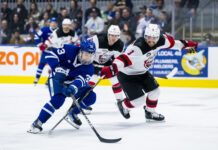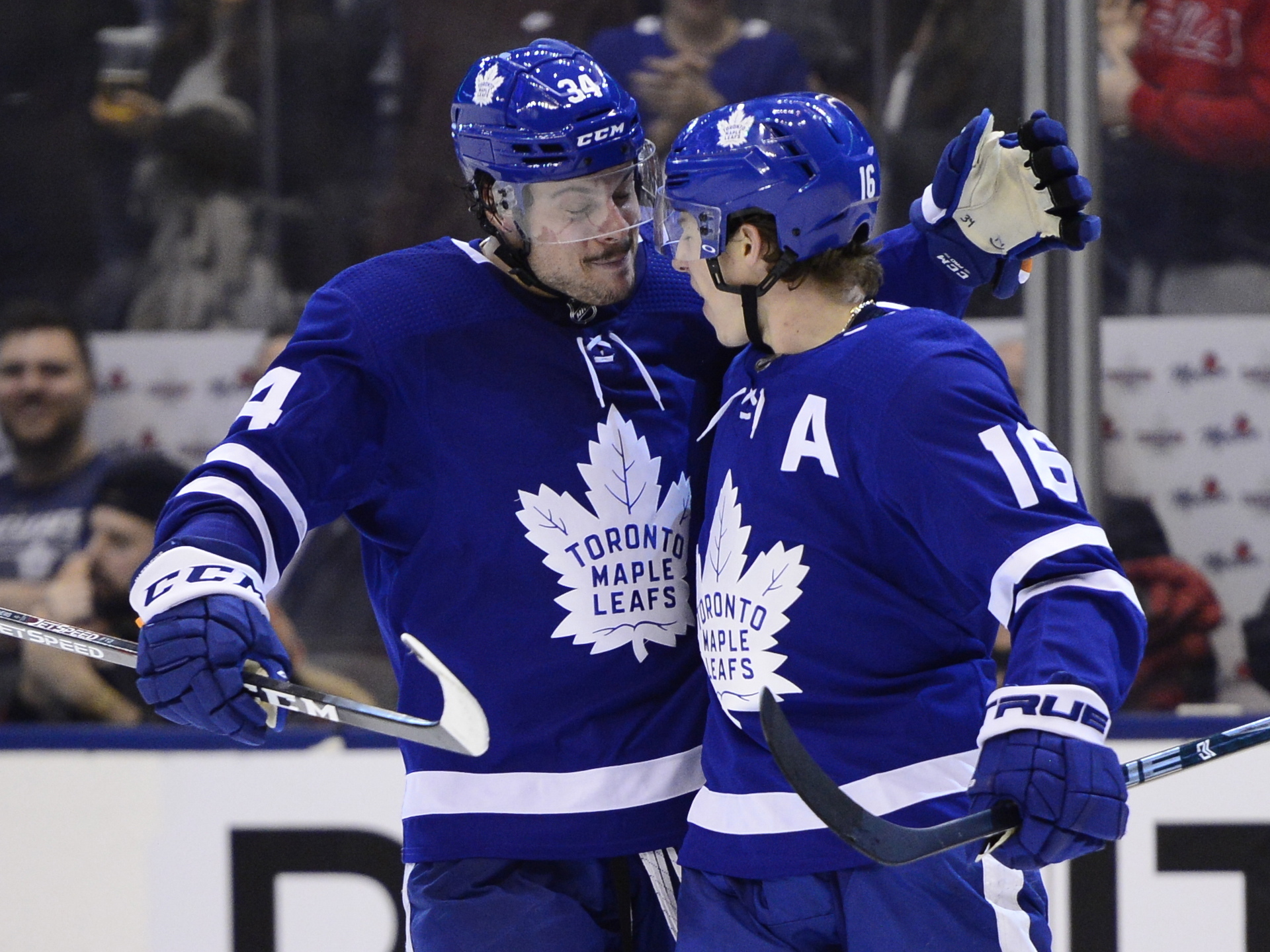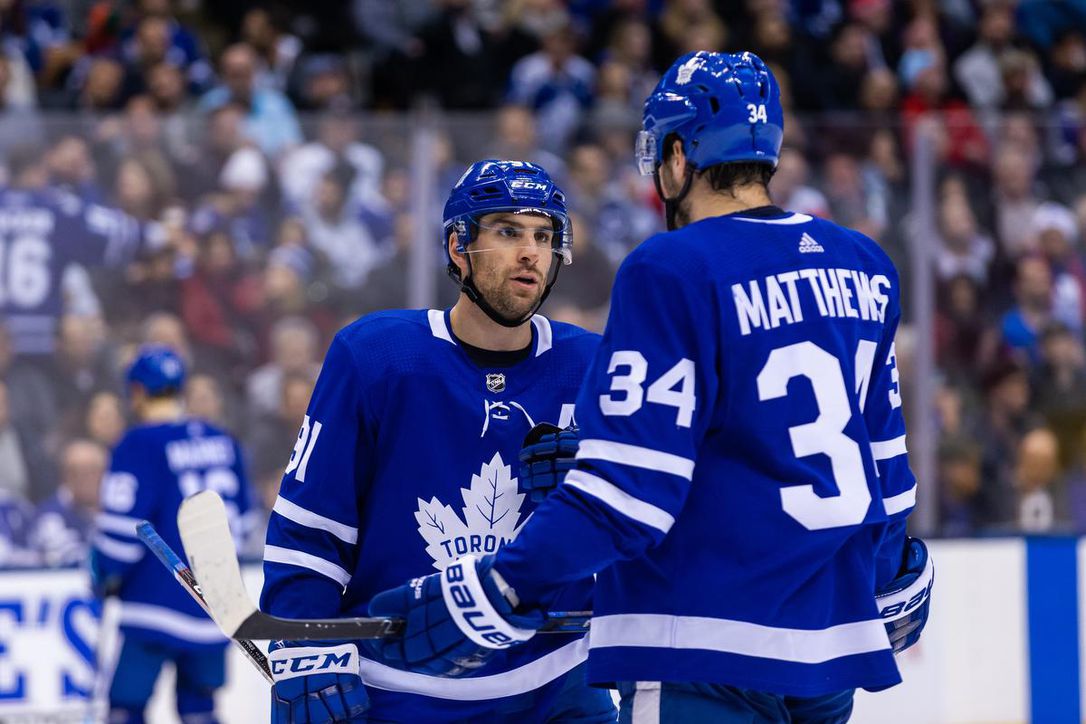The first look at line combinations in training camp always fires up Leafs fans, and that’s particularly true when we have a future HHOFer in Joe Thornton arriving in town to chase a Stanley Cup, penciled into the lineup next to the team’s superstar center in Auston Matthews.
I have no doubt we are going to see some awesome moments come out of this, similar to Jason Spezza’s goal on the opening shift next to John Tavares in the memorable next-generation game versus Carolina last season.
Taking a step back, though, there is a lot to consider here.
Firstly, before we dive into the minutiae of it, there is definitely an element of both respect for Jumbo and of promoting the organizational program at play. In other words, respected veterans — let alone HHOF-bound legends — who come to contend in Toronto on the cheap are going to receive opportunities next to top talent to start and at different times throughout the season. Sheldon Keefe freely admitted that shifts next to these two linemates were a part of the pitch. In his homecoming debut, no one can reasonably argue with Jumbo starting on the line for the opening faceoff next Wednesday vs. the Habs.
(A little different but a somewhat similar idea applies to Zach Bogosian starting on the bottom pairing; remember, he reportedly left a little bit of money on the table to come to Toronto. The Leafs also always give their Euro signings a good honest look to start the year, so Alex Barabanov’s inclusion in the top 12 isn’t surprising).
With Keefe, we know it will be a fluid situation game-to-game and even within periods within games. Looking at the lines, though, the current setup brings about some obvious questions, from deployment, to the management of Thornton’s minutes, to overall ice time distribution.
Zach Hyman is the Leafs’ third-best winger who immediately lifts either of the top six lines by not only providing the dirty work that benefits them offensively but making them better defensively, increasing the best-on-best matchup credibility of either the Matthews or Tavares line.
If we assume the Kerfoot line is only playing a secondary checking line role — as in, occasionally taking a tough matchup/zone start assignment when needed as opposed to hard matching — and playing relatively limited 5v5 minutes, will Hyman’s utility be maximized there, when he could be supporting Matthews and helping the Leafs win those best-on-best matchups more consistently? Hyman was deservedly among the top two or three Leafs forwards in ice time on many nights last season, finishing with a career-high 19:06/game.
Hypothetically, if the Kerfoot line pans out as a checking line that can competently match up throughout a game against the best opposition, are there enough 5v5 minutes to go around to get the most out of the handsomely-paid core four of Matthews/Marner and Tavares/Nylander, even knowing the matchup benefits it creates?
We saw this dilemma play out with Nazem Kadri, who was a more credible shutdown C option than Kerfoot. You may remember the much-talked-about statistic from 2018-19 that had Matthews outside of the top 50 in the NHL in total time on ice per game with Tavares and Kadri on the roster. It was partly due to middling power-play time, but he was outside the top 30 at even strength as well. All indications from Keefe last season are he is unlikely to turn back the page there, especially knowing Matthews has only evolved in his 200-foot play since.
All of that said, with the unique structure of the season — the regular season is going to be largely played in a bunch of mini-series against the same six opponents — it means the Leafs, even more than usual, don’t have to be married to any one approach. They can tackle a three-game series against Vancouver, who have a major matchup headache with Miller – Pettersson – Boeser, quite differently than one versus Ottawa or Montreal (not to disrespect the Danault, Gallagher, and Tatar line, which can hang with the elite in the league in terms of controlling 5v5 play). The fact that the Leafs start with Canadiens – Senators – Senators in their first three games presents a good opportunity to give a few ideas a trial run that might not have been in consideration had the first few matchups included Connor McDavid and Mark Scheifele.
I certainly don’t have it all figured out yet. Even Sheldon Keefe almost certainly doesn’t, either. It appears to be more about options, staying flexible, and making adjustments as they go. The Kerfoot line experiment seems to be a case of finding out if there is a hard-to-play-against checking line here that could handle some tough assignments. We know what the Leafs have in Matthews-Marner/Nylander and Tavares-Marner/Nylander. Finding a third combination the team could turn to in important situations is a big part of making the Leafs a harder team to handle and match up against, particularly come playoff time.
Especially if either of the Leafs’ elite centers is out of the lineup for an extended period of time, it’s critical that Keefe finds real solutions down the lineup, including whether Kerfoot is a full-time solution at C (I’m not 100% convinced, but Keefe seems keen on it and I can see why he wants more time to find out by trying out a line around him that could form an actual identity. We can be reasonably assured that Thornton can give the team decent enough sheltered third-line C minutes, but the Kerfoot question is one we’ll want answered before the trade deadline).
With a fully healthy lineup, the ability to move Tavares up with Matthews and Marner for segments of games — ideally for the odd mismatch in the offensive zone — without leaving the team totally exposed in behind the power line would be another benefit gained from establishing the Mikheyev – Kerfoot – Hyman option, should it work out.
More than anything, the data collected on each configuration makes for no surprises come playoff time, when first-time looks at lines are far from ideal. There isn’t a ton of time to mess around here given the nature of no exhibitions and a short regular season, but I can see some logic to the process the coaching staff is undertaking here.
The defensive depth
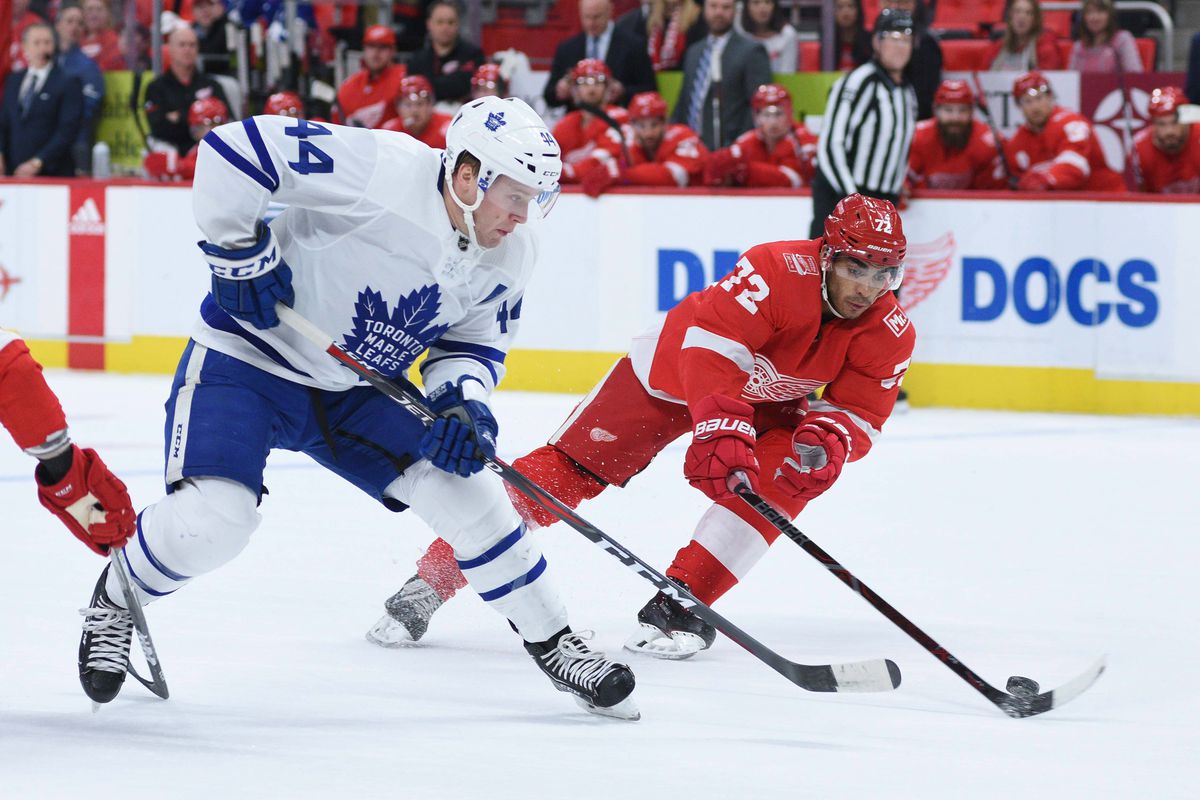
It feels like TJ Brodie’s name hasn’t been mentioned enough so far through the start of training camp.
That’s probably because there aren’t a lot of storylines to debate around the subject before the games start. Brodie is definitely starting next to Morgan Rielly, whose best ever partner in Toronto to date was Ron Hainsey. There was similar talk back when Barrie was added, but that was always an awkward stylistic fit, one that didn’t consist of the complementary skill sets required to form a balanced pairing.
Brodie has capably played far more minutes against elite competition than Barrie, he is superior with his stick and details defensively, and he can skate and move the puck; he’s played a lot of power-play minutes over his career, but it is less of an essential part of his identity as a player at this stage of his career, and he’s likely to be largely preserved for 5v5 and PK in Toronto. We can have a reasonable degree of confidence in Rielly’s pairing working out — hopefully, finally, the Leafs have more than one pair here that doesn’t terrify you defensively in a tough matchup — and the overall depth is improved on the blue line.
For a team that had a single injury (Muzzin) force it to roll out the following group of six in an elimination playoff game last October, the improvement is notable and cause for genuine optimism.
Game 4 vs. CBJ
Morgan Rielly – Cody Ceci
Martin Marincin – Justin Holl
Travis Dermott – Tyson Barrie
Injured: Muzzin
Extras: Calle Rosen, Rasmus Sandin
Current Defense
Morgan Rielly – TJ Brodie
Jake Muzzin – Justin Holl
Mikko Lethonen – Zach Bogosian
Extras: Travis Dermott, Rasmus Sandin
The biggest question marks: 1) Jake Muzzin’s ability to stay healthy, although the improved depth, particularly on the left side, mitigates some of the worries there; 2) Can the Leafs can find a solution internally on the right side if Justin Holl doesn’t carry his play over from last regular season and appears out of his depth (could Dermott or Lehtonen play the right, and to what extent could Bogosian provide veteran cover?).
The power play
On the power play, I’m curious to see how committed how the Leafs’ coaching staff — led by Manny Malhotra on this file — really are to establishing two units in terms of the ice-time share. The one-minute PP shifts for Matthews were a big point of controversy in the late aughts of the Mike Babcock era, so we’ll see how they strike the balance.
Adding Thornton and Simmonds up front in place of Kapanen and Johnsson — 5v5 abilities aside — theoretically lends itself better to two working units as both have historically been successful power-play specialists in their respective roles.
I doubt it goes as far as splitting up Matthews and Marner, but does Nylander return to PP2, joining newcomers Thornton and Mikko Lehtonen on that unit? It seems likely if we assume Simmonds starts at the front of the net with the Matthews unit, with the aim of getting Simmonds rolling right away, particularly knowing he’ll have limited 5v5 opportunity early based on the starting lines.
We’ll have a better idea of the team’s thinking here when the club starts practicing special teams on the ice tomorrow. This is where the team left off in the playoffs:
Nylander
Marner – Tavares – Matthews
Barrie
Kapanen
Robertson – Kerfoot – Spezza
Rielly
Possible new units:
Simmonds
Marner – Tavares – Matthews
Rielly
Hyman
Spezza – Nylander – Thornton
Lehtonen
If they’re sticking with the top unit sans Tyson Barrie from last season — which was white-hot when Keefe first took over, but fairly middling in the final few months of the season — we’re likely looking at:
Nylander
Marner – Tavares – Matthews
Rielly
Simmonds
Spezza – Mikheyev/Hyman – Thornton
Lehtonen
Auston Matthews on the PK?
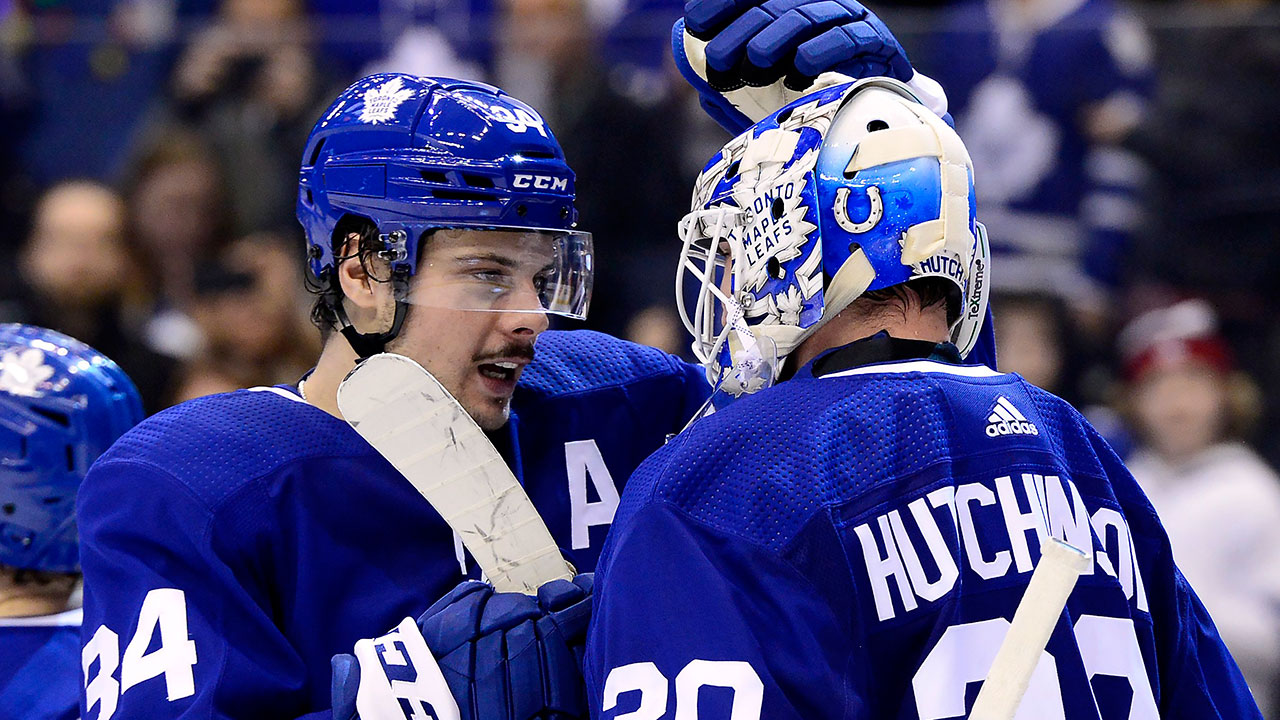
This quote from Sheldon Keefe generated buzz today:
One of the things we are going to be doing starting today in the meetings and then heading onto the ice tomorrow: We are going to get some reps for Auston Matthews and Jason Spezza. We want to get those guys comfortable and at least knowing the look of the penalty kill — in Auston’s case, in particular, as it’s something he hasn’t done.
I don’t expect it to be any time of full-time role or responsibility, but on a part-time basis, as needed, we want to start getting him comfortable with those situations. Faceoffs, in particular, is an area where he can bring a lot to us on the left side. We’ve seen so much in his growth as a defensive player and we think he can bring a lot to the penalty kill.
Obviously, the offensive threat that he is on the ice, in addition to our other penalty killers, brings a lot, too. We are going to start to get him some minutes in that regard this season.
Somewhat quietly, Matthews grew into a 55% faceoff man last season. The Leafs had Zach Hyman leading the team in shorthanded draws taken while winning less than 50% of them. Frederik Gauthier would take some left-sided draws, but he was let go in the offseason. That means the Leafs’ PK regulars three wingers and one center — Alex Kerfoot — who wasn’t particularly strong on the dot last year. Of note: among right-handed options, Jason Spezza won 70% of the limited number of draws he took shorthanded.
Matthews’ big reach, strength, pick-pocket ability, and other-worldly knack for corralling pucks out of midair, on top of the obvious abilities offensively, are all assets here if he buys into the responsibility, but it should obviously be a fringe role — an option to mix in situationally outside the main four forwards: Marner, Hyman, Mikheyev, and Kerfoot — given the value of preserving him for 5v5 and PP.
Last season, there were only two forwards in the NHL to play over 17 minutes at even strength and over 20 seconds a game on the penalty kill: Leon Draisaitl (52 seconds/game) and Dylan Larkin (45 seconds/game). McDavid played over a minute/game shorthanded in 2017-18 and over 30 seconds there in 2018-19 before the Oilers scaled back his time there last season. Anze Kopitar was around a two minute/game PKer between 2017-19, but he dropped in both even-strength TOI and shorthanded TOI last season. Mark Scheifele played over a minute per game on the PK in 2018-19, but he didn’t play much of a role there last season. Sidney Crosby played a shade over 30 seconds a game on the PK in 2018-19 but not last season. That’s basically it among 17+ minute even-strength forwards in the past three seasons.














